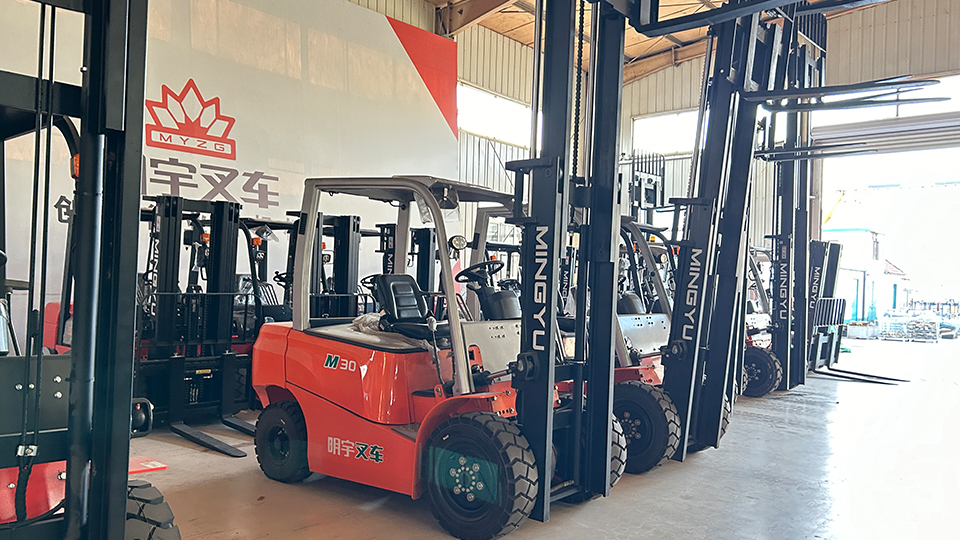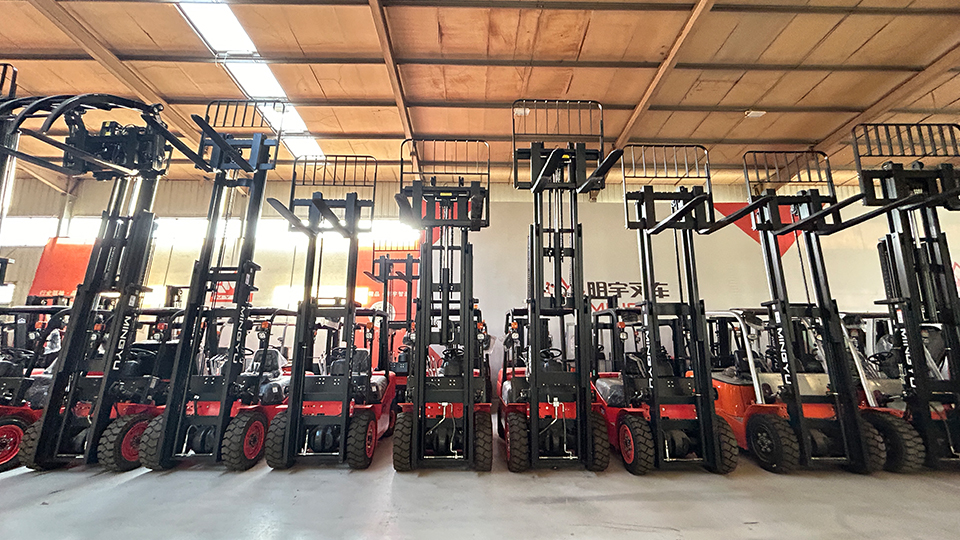
The Rolling Foundation: Knowing When to Replace Your Forklift Tires
Forklift tires are the unsung heroes of material handling operations. They provide the crucial interface between the machine and the operating surface, directly impacting safety, efficiency, operator comfort, and even the lifespan of other forklift components. Unlike the tires on your personal vehicle, forklift tires endure extreme stresses, carrying heavy loads, navigating tight corners, and often operating on abrasive surfaces. Consequently, understanding when to replace them is not just a matter of preventative maintenance; it's a critical aspect of ensuring a safe and productive work environment. Ignoring worn or damaged forklift tires can lead to a cascade of problems, from compromised stability and reduced traction to increased fuel consumption and potential accidents. This technical article delves deep into the indicators, factors, and best practices for determining when it's time to replace your forklift tires, providing a comprehensive guide for maintenance personnel and fleet managers.
The Critical Role of Forklift Tires:
Before discussing replacement indicators, it's essential to appreciate the multifaceted role forklift tires play:
Load Support: Tires are the primary load-bearing components, responsible for supporting the weight of the forklift itself and the materials it carries. Proper tire condition ensures even weight distribution and prevents undue stress on the axles, bearings, and mast components.
Traction and Maneuverability: The tire tread pattern and material provide the necessary grip for efficient acceleration, braking, and maneuvering. Worn tires lose traction, leading to wheel slippage, reduced control, and increased stopping distances, especially on inclines or wet surfaces.
Stability: Tires contribute significantly to the overall stability of the forklift, particularly when lifting and transporting loads at height. Uneven or damaged tires can compromise stability, increasing the risk of tipping.
Operator Comfort: Properly inflated and maintained tires absorb shocks and vibrations, contributing to a smoother and more comfortable ride for the operator. This can reduce fatigue and improve productivity.
Floor Protection: The type and condition of the tires directly impact the wear and tear on the facility floor. Using the wrong type of tire or operating on damaged tires can lead to premature floor degradation and costly repairs.

Fuel Efficiency (IC Forklifts): While less direct than in combustion engines, tire condition affects the rolling resistance. Worn or underinflated tires increase rolling resistance, requiring more power from the engine to move the forklift, thus impacting fuel consumption. For electric forklifts, increased rolling resistance drains the battery faster.
Key Indicators for Forklift Tire Replacement:
Identifying when to replace forklift tires requires a proactive approach involving regular inspections and awareness of key wear indicators:
Wear Line Exposure: Most solid and cushion press-on tires are equipped with a wear line indicator, typically a groove or a change in the tire's profile. When the wear reaches this line, it signifies that the tire has reached its safe operating limit and must be replaced immediately. Ignoring this indicator significantly increases the risk of tire failure and accidents.
Chunking and Tearing: Operating on rough or debris-strewn surfaces can cause chunks of rubber to break off or the tire to tear. Significant chunking or tearing compromises the tire's structural integrity, reduces contact area, and affects stability. Tires exhibiting such damage should be replaced promptly, regardless of the overall wear depth.
Flat Spots: Heavy braking or skidding can create flat spots on the tire's surface. These flat spots cause uneven weight distribution, leading to vibrations, reduced traction, and accelerated wear on other parts of the forklift and the floor. Tires with noticeable flat spots should be replaced.
Cracking: Over time, exposure to UV radiation, chemicals, and general wear can cause cracks to appear in the tire sidewall or tread. While small surface cracks might be superficial, deep or numerous cracks indicate degradation of the rubber compound and an increased risk of tire failure. Tires with significant cracking should be replaced.
Uneven Wear: Irregular wear patterns, such as excessive wear on one side of the tire or cupping (scalloped wear), can indicate underlying mechanical issues with the forklift, such as misalignment, worn bearings, or brake problems. Addressing the mechanical issue is crucial, and the unevenly worn tires should also be replaced to ensure proper contact and stability.
Tire Diameter Discrepancy: Significant differences in diameter between tires on the same axle can cause the forklift to pull to one side, strain the drivetrain, and accelerate wear on the smaller tire. If the diameter difference exceeds the manufacturer's specifications, the tires should be replaced as a set.
Ride Quality Degradation: A noticeable increase in vibration or a rougher ride can be an indication of internal tire damage or excessive wear, even if visual indicators are not immediately apparent. Operators often become accustomed to gradual changes, so regular checks and feedback from operators are important.
Age of Tires: Even if tires haven't reached their wear limit or show significant damage, the rubber compound degrades over time, losing its elasticity and increasing the risk of failure. Most manufacturers recommend replacing forklift tires after a certain number of years (typically 5-7 years), regardless of tread depth. Check the tire sidewall for the date of manufacture.
Specific Application Requirements: Certain applications may have specific tire requirements for optimal performance and safety. For example, operations requiring high traction on slippery surfaces might necessitate tires with a specific tread pattern that needs replacement once it wears down beyond a certain point, even if the wear line hasn't been reached.
Factors Influencing Tire Wear and Replacement Frequency:
Several factors can significantly impact the rate at which forklift tires wear and the frequency of replacement:
Operating Surface: Rough, abrasive surfaces like concrete with debris will accelerate tire wear compared to smooth, clean surfaces.
Load Weight: Consistently carrying heavy loads puts more stress on the tires, leading to faster wear.
Operating Intensity and Distance Traveled: Forklifts operating for long hours and covering significant distances will experience more tire wear.
Driving Habits: Aggressive driving, including rapid acceleration, hard braking, and sharp turns, significantly increases tire wear.
Tire Type and Compound: Different tire compounds and constructions offer varying levels of wear resistance. Selecting the appropriate tire type for the application is crucial.
Maintenance Practices: Proper inflation pressure (for pneumatic and some solid pneumatic tires) and regular cleaning can help maximize tire lifespan. Neglecting maintenance can lead to premature wear and damage.
Environmental Conditions: Exposure to extreme temperatures, UV radiation, and certain chemicals can accelerate tire degradation.
Best Practices for Forklift Tire Management:
Implementing proactive tire management practices can help optimize tire lifespan, improve safety, and reduce operational costs:

Regular Inspections: Conduct daily pre-shift inspections and more thorough weekly or monthly inspections of all forklift tires, looking for the wear indicators mentioned above. Document all inspections and any findings.
Operator Training: Educate forklift operators on the importance of proper driving techniques to minimize tire wear, such as avoiding rapid acceleration, hard braking, and unnecessary spinning of the wheels.
Scheduled Maintenance: Include tire checks and maintenance as part of the regular forklift maintenance schedule.
Proper Inflation Pressure (for applicable tires): Maintain the manufacturer's recommended inflation pressure for pneumatic and solid pneumatic tires. Underinflation and overinflation can both lead to premature wear and safety hazards.
Surface Maintenance: Keep operating surfaces as clean and free of debris as possible to minimize cuts, tears, and accelerated wear.
Matching Tire Types: Ensure that all tires on the same forklift are of the same type, size, and construction to maintain proper handling and stability.
Accurate Record Keeping: Maintain records of tire replacements, including the date, type of tire, and reason for replacement. This data can help identify trends and optimize future tire selection and maintenance practices.
Consider Tire Fill Options: For pneumatic tires operating in environments prone to punctures, consider options like foam filling or solid tires to eliminate flat tires and associated downtime.
Consult Manufacturer Recommendations: Always refer to the forklift and tire manufacturer's recommendations for specific guidelines on tire maintenance, wear limits, and replacement intervals.
Consequences of Neglecting Tire Replacement:
Failing to replace worn or damaged forklift tires can have significant negative consequences:
Safety Hazards: Reduced traction, compromised stability, and increased stopping distances can lead to accidents, potentially causing injuries to personnel and damage to property.
Reduced Productivity: Wheel slippage, rough rides, and difficulty maneuvering can slow down operations and reduce overall productivity.
Increased Maintenance Costs: Operating on worn tires can put undue stress on other forklift components, leading to premature wear and costly repairs to axles, bearings, and the drivetrain.
Floor Damage: Worn or damaged tires can damage the facility floor, requiring expensive repairs.
Operator Fatigue: Rough rides caused by worn tires can contribute to operator fatigue and discomfort.
Load Damage: Instability and jerky movements due to poor tire condition can increase the risk of damaging the materials being handled.
Conclusion:
Knowing when to replace forklift tires is a critical aspect of responsible forklift ownership and operation. By understanding the key wear indicators, considering the factors that influence tire wear, and implementing proactive maintenance practices, businesses can ensure a safer, more efficient, and cost-effective material handling operation. Regular inspections, operator training, and adherence to manufacturer recommendations are essential components of a comprehensive tire management program. Ignoring the rolling foundation of your forklifts is a risk not worth taking; timely replacement of worn or damaged tires is an investment in safety, productivity, and the longevity of your equipment
Name: selena
Mobile:+86-13176910558
Tel:+86-0535-2090977
Whatsapp:8613181602336
Email:vip@mingyuforklift.com
Add:Xiaqiu Town, Laizhou, Yantai City, Shandong Province, China